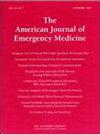感染性休克早期抗利尿激素加去甲肾上腺素vs延迟或不抗利尿激素:一项系统回顾和荟萃分析。
IF 2.2
3区 医学
Q1 EMERGENCY MEDICINE
引用次数: 0
摘要
简介:去甲肾上腺素是脓毒性休克的一线抗利尿激素,如果休克持续,通常会加用抗利尿激素。有证据表明,早期开始使用抗利尿激素可以改善血液动力学和临床结果;然而,数据仍然相互矛盾。这项荟萃分析评估了早期抗利尿激素的使用。方法:我们检索PubMed、Embase和Cochrane,以比较早期抗利尿激素联合去甲肾上腺素与单独使用去甲肾上腺素或后期抗利尿激素治疗感染性休克的研究。结果包括住院和ICU住院时间(LOS)、SOFA评分、血管升压持续时间、死亡率(住院和28天)、心律失常和肾脏替代治疗(RRT)。采用随机效应模型。使用RoB2和ROBINS-I工具评估偏倚风险。结果:6项研究(n = 1167例患者)符合纳入标准,包括2项rct。早期抗利尿激素与较短的住院LOS相关(平均差[MD] -4.48天;95% CI -8.37至-0.60;p = 0.02; I2 = 44%)。ICU LOS (MD -0.73天,p = 0.42)、血管升压持续时间(MD -8.77小时,p = 0.18)、24或72小时SOFA评分、住院死亡率(or 0.86, p = 0.38)、28天死亡率(or 0.84, p = 0.20)、心律失常风险(or 0.99, p = 0.98)或RRT使用(or 1.02, p = 0.91)方面均无显著差异。在大多数纳入的研究中,特别是在观察性设计中,偏倚风险很高。结论:早期抗利尿激素可降低脓毒性休克的住院LOS,但不能改善死亡率或其他结局。尽管可能有好处,但目前的证据并不支持常规的早期使用。本文章由计算机程序翻译,如有差异,请以英文原文为准。
Early vasopressin plus norepinephrine versus delayed or no vasopressin in septic shock: A systematic review and meta-analysis
Introduction
Norepinephrine is the first-line vasopressor in septic shock, with vasopressin commonly added if shock persists. Evidence suggests that early initiation of vasopressin may improve hemodynamic and clinical outcomes; however, data remain conflicting. This meta-analysis evaluates early vasopressin administration.
Methods
We searched PubMed, Embase, and Cochrane for studies comparing early vasopressin plus norepinephrine versus norepinephrine alone or later vasopressin initiation in septic shock. Outcomes included hospital and ICU length of stay (LOS), SOFA score, vasopressor duration, mortality (in-hospital and 28-day), arrhythmias, and renal replacement therapy (RRT). A random-effects model was used. Risk of bias was assessed using RoB2 and ROBINS-I tools.
Results
Six studies (n = 1167 patients) met inclusion criteria, including two RCTs. Early vasopressin was associated with a significantly shorter hospital LOS (mean difference [MD] -4.48 days; 95 % CI -8.37 to −0.60; p = 0.02; I2 = 44 %). No significant differences were observed for ICU LOS (MD -0.73 days; p = 0.42), vasopressor duration (MD -8.77 h; p = 0.18), SOFA scores at 24 or 72 h, in-hospital mortality (OR 0.86; p = 0.38), 28-day mortality (OR 0.84; p = 0.20), arrhythmia risk (OR 0.99; p = 0.98), or RRT use (OR 1.02; p = 0.91). Risk of bias was high in most included studies, particularly among observational designs.
Conclusion
Early vasopressin may reduce hospital LOS in septic shock but does not improve mortality or other outcomes. Even though there is a possible benefit, current evidence does not support routine early use.
求助全文
通过发布文献求助,成功后即可免费获取论文全文。
去求助
来源期刊
CiteScore
6.00
自引率
5.60%
发文量
730
审稿时长
42 days
期刊介绍:
A distinctive blend of practicality and scholarliness makes the American Journal of Emergency Medicine a key source for information on emergency medical care. Covering all activities concerned with emergency medicine, it is the journal to turn to for information to help increase the ability to understand, recognize and treat emergency conditions. Issues contain clinical articles, case reports, review articles, editorials, international notes, book reviews and more.

 求助内容:
求助内容: 应助结果提醒方式:
应助结果提醒方式:


